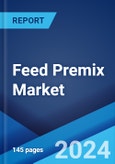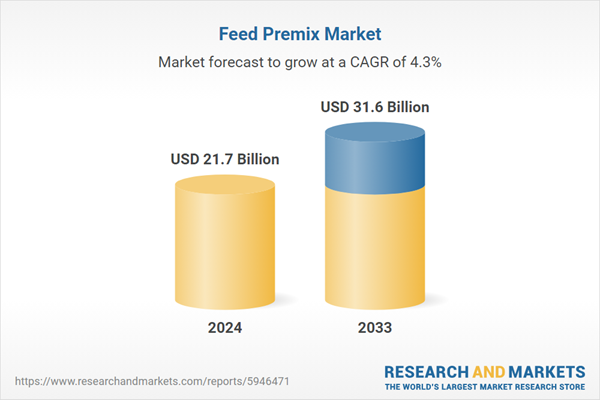Feed premix is a specialized mixture of essential nutrients, vitamins, minerals, amino acids, and other additives that are blended into animal feed to ensure optimal nutrition and health for livestock. It is being used extensively in the livestock industry to enhance the quality of animal feed, allowing farmers to provide a balanced and complete diet to their animals. These premixes are carefully formulated according to the specific dietary requirements of different animal species, growth stages, and production goals. By incorporating feed premixes into the animal feed production process, farmers can effectively address nutritional deficiencies and promote the well-being and performance of their livestock.
The growth of the global feed premix market is primarily driven by the increasing demand for high-quality animal products, coupled with a rising awareness among livestock farmers about the significance of balanced animal nutrition. Besides this, as consumer preferences for nutritious and safe animal-derived products continue to surge, livestock producers are emphasizing the use of feed premixes to enhance the health, growth, and productivity of their animals, creating a favorable market outlook. Moreover, the expansion of the livestock industry to meet the growing global population's protein requirements is fostering the adoption of feed premixes. In addition to this, ongoing technological advancements and research in animal nutrition are acting as other crucial factors contributing to the market's growth, enabling the development of specialized premix formulations that cater to different animal species and their specific nutritional needs. Furthermore, regulatory efforts to ensure the safety and quality of animal feed additives are encouraging manufacturers to innovate and offer compliant feed premix solutions, further propelling the market's expansion.
Feed Premix Market Trends/Drivers:
Increasing demand for quality animal products
The escalating demand for high-quality animal products, such as meat, milk, and eggs, represent one of the key factors impelling the global feed premix market. Concurrent with this, as consumers worldwide seek safer, healthier, and more nutritious options, livestock farmers are under pressure to improve the quality of their products, fueling the demand for feed premixes. Additionally, feed premixes play a crucial role in achieving this goal, as they ensure that animals receive the essential nutrients necessary for optimal growth, development, and overall health. By incorporating premixes into their feed formulations, farmers can enhance the nutritional value of animal products, meeting consumer expectations and bolstering their market competitiveness.Growing awareness of balanced animal nutrition
The increasing awareness among livestock farmers about the significance of balanced animal nutrition is acting as another growth-inducing factor in the feed premix market. With a better understanding of the direct correlation between proper nutrition and animal performance, farmers are recognizing the need to provide their animals with scientifically formulated diets, thus strengthening the market growth. In confluence with this, feed premixes offer a convenient and efficient way to deliver a precise combination of various vitamins, essential minerals, amino acids, and other additives that animals require for various physiological functions. This heightened awareness is leading to higher adoption of feed premixes across different livestock sectors, including poultry, swine, and cattle, thereby creating a favorable outlook for market expansion.Expansion of the livestock industry
The rapid expansion of the global livestock industry to meet the rising demand for animal-derived protein is contributing to the increasing demand for feed premixes. Moreover, as the global population continues to grow, so does the need for protein-rich food sources. This expansion necessitates efficient animal production systems that can yield higher quantities of meat, milk, and eggs. Feed premixes enable livestock producers to optimize their animals' growth rates and feed efficiency, resulting in increased output. Apart from this, the surging incorporation of premixes tailored to specific animal species and growth stages, allowing farmers to maximize their productivity while ensuring the animals' well-being, is bolstering the market growth.Feed Premix Industry Segmentation:
The publisher provides an analysis of the key trends in each segment of the global feed premix market report, along with forecasts at the global, regional, and country levels for 2025-2033. Our report has categorized the market based on ingredient type, form, and livestock.Breakup by Ingredient Type:
- Amino Acids
- Vitamins
- Minerals
- Antibiotics
- Antioxidants
- Others
Amino acids dominate the market
The report has provided a detailed breakup and analysis of the market based on the ingredient type. This includes amino acids, vitamins, minerals, antibiotics, antioxidants, and others. According to the report, amino acids represented the largest segment.The demand for amino acid feed premix is propelled by the heightened focus on optimizing animal diets to achieve maximum growth efficiency and nutritional value. Amino acids, as an essential building block of proteins, play a crucial part in various physiological functions and growth processes within animals. Besides this, livestock producers are increasingly recognizing the importance of incorporating precise amino acid profiles into animal feed to enhance protein synthesis, improve feed utilization, and minimize wastage, bolstering product demand. Moreover, this targeted approach fosters better growth rates and aligns with sustainable farming practices by minimizing excess nutrient excretion. As a result, the demand for amino acid feed premixes is surging as an integral component of modern livestock nutrition strategies.
Breakup by Form:
- Dry
- Liquid
Dry holds the largest share in the market
A detailed breakup and analysis of the market based on the form has also been provided in the report. This includes dry and liquid. According to the report, dry accounted for the largest market share.The expanding demand for dry feed premix due to its convenience, extended shelf life, and compatibility with various animal feed formulations represent one of the main drivers impelling the market growth. Dry feed premixes offer a practical solution for livestock farmers and feed manufacturers, as they are easy to handle, store, and mix with different feed ingredients. In addition to this, the extended shelf life of dry premixes ensures their stability and effectiveness over time, reducing the risk of nutrient degradation. Additionally, their compatibility with a wide array of animal feed formulations, including pellets, extruded feeds, and textured feeds, makes them versatile and adaptable to diverse livestock production systems. As a result, the demand for dry feed premixes is witnessing a steady rise as they contribute to the efficiency and consistency of animal nutrition programs.
Breakup by Livestock:
- Poultry
- Ruminants
- Swine
- Aquatic Animals
- Equine
- Pets
Poultry dominates the market
The report has provided a detailed breakup and analysis of the market based on the livestock. This includes poultry, ruminants, swine, aquatic animals, equine, and pets. According to the report, poultry represented the largest segment.The dynamic growth of the poultry industry and the quest for improved production efficiency are acting as significant growth-inducing factors. Moreover, poultry farming, especially broiler and layer production, is expanding rapidly to meet the escalating global demand for affordable and protein-rich meat and eggs. As a result, there is a growing demand for feed premixes tailored specifically for poultry to address the sector's unique nutritional requirements, supporting optimal growth, egg production, and overall health. The inclusion of precise blends of vitamins, minerals, amino acids, and additives in poultry feed premixes ensures that birds receive balanced nutrition, enhancing feed conversion rates and reducing production costs, creating a surging product demand. As poultry production scales up to cater to evolving dietary preferences, the demand for specialized feed premixes remains a driving force in sustaining the industry's growth trajectory.
Breakup by Region:
Feed Premix Market
- North America
- United States
- Canada
- Asia Pacific
- China
- Japan
- India
- South Korea
- Australia
- Indonesia
- Others
- Europe
- Germany
- France
- United Kingdom
- Italy
- Spain
- Russia
- Others
- Latin America
- Brazil
- Mexico
- Others
- Middle East and Africa
Asia-Pacific exhibits a clear dominance, accounting for the largest feed premix market share
The market research report has also provided a comprehensive analysis of all the major regional markets, which include North America (the United States and Canada); Asia Pacific (China, Japan, India, South Korea, Australia, Indonesia, and others); Europe (Germany, France, the United Kingdom, Italy, Spain, Russia, and others); Latin America (Brazil, Mexico, and others); and the Middle East and Africa. According to the report, Asia-Pacific accounted for the largest market share.Asia Pacific's evolving livestock production landscape is creating a growing demand for feed premixes. Moreover, the region's burgeoning population and rising disposable incomes are driving increased demand for animal-derived products, compelling livestock producers to adopt advanced nutrition strategies. Additionally, the expansion of the aquaculture and poultry sectors in countries including China, India, and Vietnam is boosting the need for specialized feed premix solutions tailored to diverse species and growth stages. Concurrent with this, the region's proactive approach to food safety and quality regulations is encouraging feed manufacturers to develop compliant premix formulations. Furthermore, collaborations between international premix suppliers and local manufacturers further promote technological transfer and innovation in formulating cost-effective and efficient feed premixes. This is fueling the growth of the Asia Pacific feed premix market as it becomes a pivotal component of sustainable and high-yielding livestock production systems.
Competitive Landscape:
The global feed premix market features a competitive landscape characterized by a blend of established players and emerging entrants striving to gain a competitive edge. Established multinational companies hold significant market shares due to extensive research capabilities, wide distribution networks, and diversified product portfolios. These industry giants focus on innovation to develop customized premix solutions that cater to various animal species and specific nutritional needs. At the same time, smaller regional players capitalize on their agility and localized expertise to cater to specific markets. As sustainability and regulatory compliance become crucial, players invest in R&D for eco-friendly premix solutions. This competitive scenario fosters innovation, product diversification, and strategic alliances, benefiting consumers through a broader range of effective and efficient feed premix options.The market research report has provided a comprehensive analysis of the competitive landscape in the market. Detailed profiles of all major companies have also been provided.
Some of the key players in the market include:
- Alltech
- Archer-Daniels-Midland Company
- Associated British Foods plc
- Avitech Nutrition Pvt. Ltd
- Cargill Incorporated
- Charoen Pokphand Foods PCL
- Dansk Landbrugs Grovvareselskab A.M.B.A.
- De Heus Animal Nutrition B.V.
- Kemin Industries Inc.
- Koninklijke DSM N.V.
- Lexington Enterprises Pte. Ltd.
- Novus International Inc.
- Nutreco N.V. (SHV Holdings)
Key Questions Answered in This Report
1. How big is the feed premix industry?2. What is the expected growth rate of the global feed premix market during 2025-2033?
3. What has been the impact of COVID-19 on the global feed premix market?
4. What are the key factors driving the global feed premix market?
5. What is the breakup of the global feed premix market based on the ingredient type?
6. What is the breakup of the global feed premix market based on the form?
7. What is the breakup of the global feed premix market based on the livestock?
8. What are the key regions in the global feed premix market?
9. Who are the key players/companies in the global feed premix market?
Table of Contents
Companies Mentioned
- Alltech
- Archer-Daniels-Midland Company
- Associated British Foods plc
- Avitech Nutrition Pvt. Ltd
- Cargill Incorporated
- Charoen Pokphand Foods PCL
- Dansk Landbrugs Grovvareselskab A.M.B.A.
- De Heus Animal Nutrition B.V.
- Kemin Industries Inc.
- Koninklijke DSM N.V.
- Lexington Enterprises Pte. Ltd.
- Novus International Inc.
- Nutreco N.V. (SHV Holdings)
Table Information
| Report Attribute | Details |
|---|---|
| No. of Pages | 132 |
| Published | January 2025 |
| Forecast Period | 2024 - 2033 |
| Estimated Market Value ( USD | $ 21.7 Billion |
| Forecasted Market Value ( USD | $ 31.6 Billion |
| Compound Annual Growth Rate | 4.3% |
| Regions Covered | Global |
| No. of Companies Mentioned | 13 |









